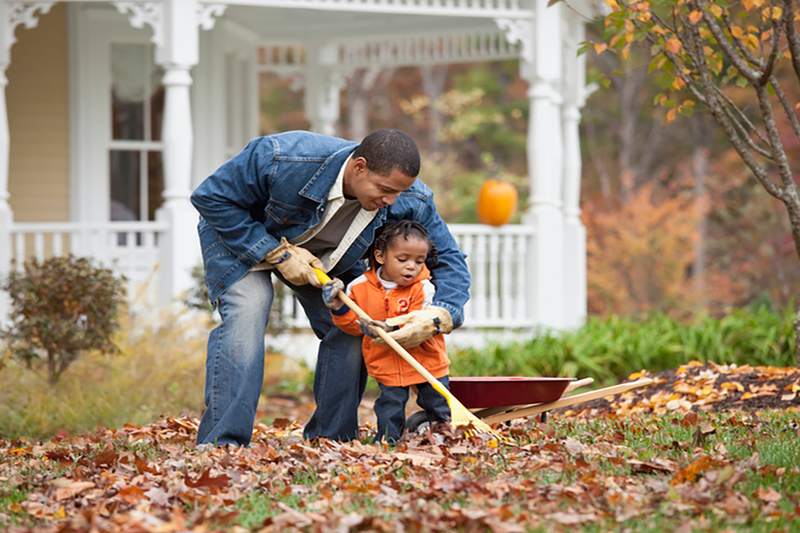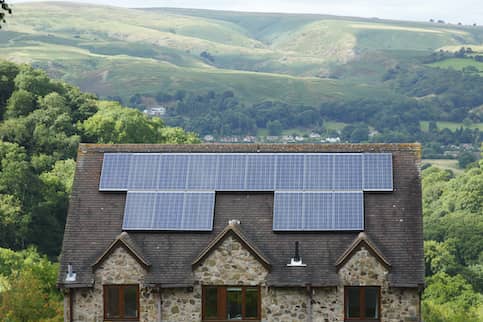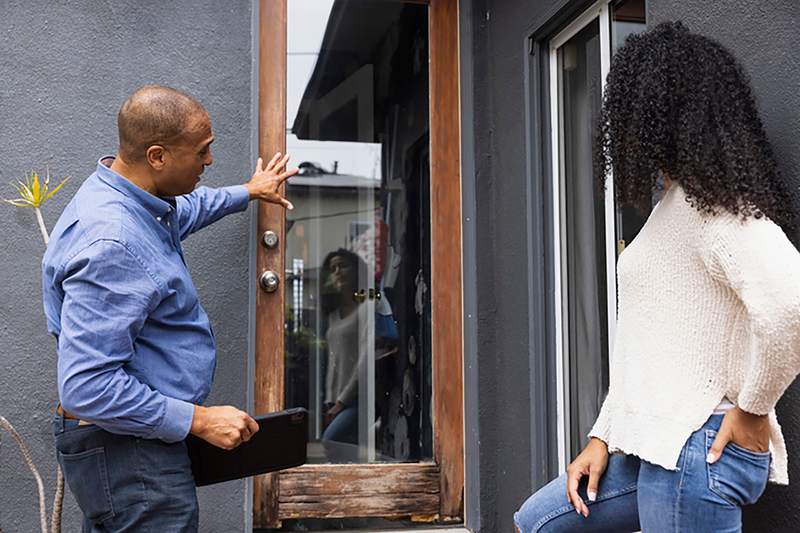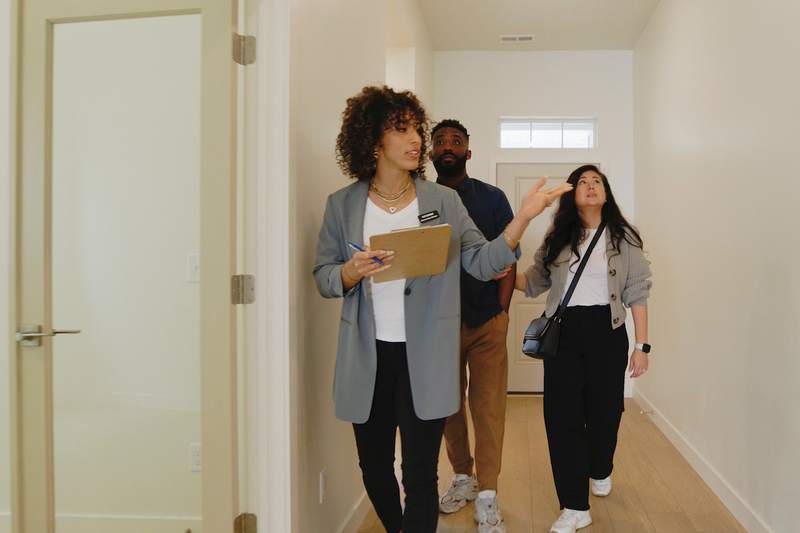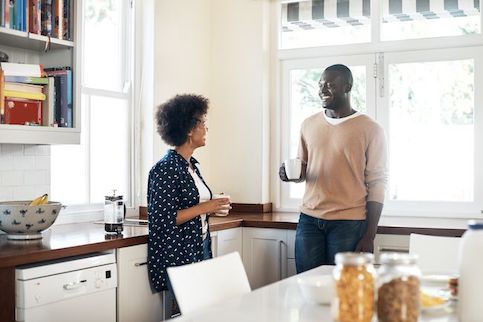Along the journey to close on a home, the final walk-through can feel like a bit of a wild card. While walk-throughs usually go off without a hitch, problems that weren’t there during previous visits can appear and cause major headaches for the buyer and seller, delaying or even canceling the deal.
The final walk-through is a crucial step before closing that verifies the property meets all your conditions. From preparing before the walk-through to taking a seat at the closing table, it’s important to understand what to expect to help ensure a smooth final walk-through.
What Is A Final Walk-Through?
The final walk-through before closing on a house is one of the last steps to buying a home. Real estate walk-throughs are typically conducted after a seller has moved out. The home buyer makes a final inspection to confirm that agreed-upon repairs have been made and there are no new issues with the home.
The final walk-through offers home buyers one last chance to evaluate a house’s condition. Buyers can confirm two key things about the property: the home is in the same condition it was in when they agreed to buy it, and any additional repairs stipulated in the purchase agreement have been completed to their satisfaction. They can also verify that no features – like light fixtures or faucets – have been removed that shouldn’t have been.
What’s Your Goal?
Buy A Home
Discover mortgage options that fit your unique financial needs.

Refinance
Refinance your mortgage to have more money for what matters.
Tap Into Equity
Use your home’s equity and unlock cash to achieve your goals.
Who Attends A Final Walk-Through?
The buyer and their real estate agent are present at the final walk-through. They’ll check that there’s no new damage, that the systems and appliances included in the sale still work and that the home is clean. Unlike a formal home inspection, a final walk-through doesn’t require a professional home inspector. However, some home buyers may schedule a separate home inspection closer to closing day.
Sellers and their agents rarely attend a final walk-through. If the seller moved out a while ago, the buyer should be on the lookout for things that may have gone wrong since the seller left.
The buyer’s participation in the final walk-through is crucial. Buying a home is a significant financial and legal investment. Skipping the final walk-through could mean paying thousands to cover unexpected conditions or repairs after you close on the home.
When Does The Final Walk-Through Take Place?
Final walk-throughs typically occur as close to closing as possible or on the same day. Usually, it happens after the seller has moved out.
When the seller’s belongings are no longer in the home, it’s easier to identify any damage or changes before finalizing the sale. The goal is to verify the home is in the same working condition as when you agreed to buy it, with any negotiated repairs.
Ready To Become A Homeowner?
Get matched with a lender that can help you find the right mortgage.
How Long Does A Final Walk-Through Take?
A thorough final walk-through can take anywhere from 30 minutes to a few hours, depending on the property’s size, the number of repairs you must inspect and any new issues you may uncover.
Don’t rush the final walk-through. Make sure you’re getting what you expected and safeguard yourself from expensive repairs after closing.
What Should You Bring To A Final Walk-Through?
To be fully prepared for the final walk-through, make sure you bring the items on our list.
- Your home purchase agreement (which lays out the terms you and the seller agreed to).
- The home inspection report (to ensure the seller made all repairs).
- A camera for photos or videos.
- A device to test outlets (a phone charger, night-light, etc.).
- A writing pad to jot down notes.
- A checklist of everything you need to review on the property.
Bringing your real estate agent along to the final walk-through is highly recommended. An experienced agent can tell you what to look for beyond the boxes on your checklist and confidently guide you through the walk-through.
Take The First Step To Buying A Home
Find a lender that will work with your unique financial situation.
Final Walk-Through Checklist
It can be easy to overlook issues in all the excitement around closing on your new house. Knowing what you must look out for in advance can help keep you focused on your requested repairs rather than distracted by decor ideas for your beautiful new foyer.
In general, you should ensure all the seller’s stuff is out of the house (unless your contract stipulates otherwise). Confirm that anything included in the sale is still there (such as kitchen appliances or home fixtures). Verify that the seller made all negotiated repairs to your satisfaction. Check that there aren’t new problems or damage in the home, particularly damage commonly associated with moving out, like scuff marks on walls or chipped doorways.
Use a checklist when you attend your final walk-through to stay focused. To help ensure your soon-to-be new home is in good shape – inside and out – confirm each relevant item on our checklist:
Outside The Home
- Ensure garage door openers and any remotes are working.
- Check for debris.
- Look for obvious signs of pests.
- Look for signs of disrepair, like damage to the yard or mailbox.
- Make sure yard features sold with the house – storage sheds, lawn ornaments, landscaping, etc. – are there and haven’t been removed.
Inside The Home
- Account for all light fixtures and outlets and make sure they work.
- Test faucets and check for leaks, test the hot water and check that all drains are properly draining water.
- Look out for mold or water damage.
- Check for evidence of a pest infestation.
- Test all appliances, including the stove, washing machine, dryer, dishwasher and garbage disposal. Make sure the refrigerator is cold.
- Check that doors and windows open, close and lock.
- Confirm all fixtures remain in the home (such as window treatments or toilet paper holders).
- Flush the toilets.
- Inspect walls and floors for damage.
- Check the garbage disposal and exhaust fans.
- Test the thermostat (heat and air conditioning) and check the HVAC units.
- Check that the seller’s belongings are gone and all debris has been removed.
- Ensure the home has been swept or vacuumed and isn’t excessively dirty.
How Can A Seller Prepare For A Final Walk-Through?
Sellers should read the purchase agreement to help prepare for the final walk-through. It will detail what repairs you must make and what items must remain at the property.
Complete Agreed-Upon Repairs
If your purchase agreement stipulates repairs before closing, getting them done on time is necessary for a successful closing. Be sure to communicate with the buyer on the progress of the repairs. If there are delays, you should be upfront about it.
Keep Your Receipts
Hang on to any receipts or paperwork related to the repairs. You should give a copy to the buyer so they can reach out to the contractors who completed the work for you if problems with the repairs come up later.
Do Some Light Cleaning
Make sure the house is clean – and don’t leave anything behind. While you may think you’re doing the buyer a favor by leaving a couch or leftover paint, you’re likely just leaving more cleanup work for them to do.
The general rule is to leave the home “broom clean.” This means the property should be swept or vacuumed and cleared of clutter. The buyer will likely do a deep clean when they move in, but you should still make sure you aren’t leaving the buyer a dirty home to move into.
Be Clear About What Stays With The House
The house must remain as it was when the buyer initially agreed to buy it (along with any changes negotiated in the contract). Disputes can arise when a seller takes something the buyer assumed was part of the deal.
Items like furniture, electronics and decor are considered personal property and usually aren’t part of a home sale. Anything affixed to the home or property is a fixture and legally considered part of the home sale. While a table lamp is personal property, a chandelier or wall sconce is a fixture.
Unless you stated in the purchase agreement that you were keeping, for example, a particular ceiling light fixture, you must leave it. If you don’t, you risk delaying or canceling the sale or having a portion of your sale proceeds held back in escrow.
Can A Buyer Back Out If They Find An Issue During The Final Walk-Through?
If a buyer uncovers issues during the final walk-through, the seller must work with the buyer to find a solution that satisfies the purchase contract. Buyers can back out if the home isn’t up to the standards stipulated in the purchase agreement and are generally refunded their earnest money. However, backing out should be an absolute last resort – nobody wins when you back out of closing.
Consider these alternatives to keep a sale on track.
Delay The Closing
You can request to delay the closing if there is damage in the home, it’s been left in an unreasonable condition or fixtures or appliances are missing. During this time, the seller can make repairs and bring the home up to the standards specified in the purchase agreement.
Your agent or attorney can handle the negotiations around delaying the closing.
Renegotiate The Contract
If the seller no longer lives nearby or balks at making repairs, you can ask to renegotiate the contract so the seller pays to remedy the problem from their sale proceeds.
Arrange An Escrow Holdback
If the seller refuses to budge on making repairs or paying for the buyer to make them, one solution could be to hold a portion of the seller’s proceeds in an escrow account. These funds can be used to cover the repair costs. Known as an escrow holdback, this solution involves holding a portion of the seller’s proceeds to cover repairs. This amount can include the cost of repairs plus a premium to incentivize the seller to deal with the problem before closing. Once the repairs are completed, the seller can get back the premium.
The Bottom Line
The final walk-through is a crucial step in the home buying process. It’s your last chance to confirm that what you agreed to purchase is what you’re getting. Before you start packing boxes for your big move-in day, look through our recommendations for new homeowner essentials to help make your new home feel like home on day one.

Victoria Araj
Victoria Araj is a Staff Writer for Rocket Companies who has held roles in mortgage banking, public relations and more in her 15-plus years of experience. She has a bachelor’s degree in journalism with an emphasis in political science from Michigan State University, and a master’s degree in public administration from the University of Michigan.




